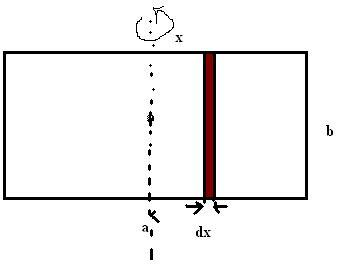 1
1for a rectangle let the length be a and breadth be b
then M.I along the length will be Ma2/12
and along the breadth will Mb2/12
then according to perpendicular axis theorem
Iz=Ix+Iy
since length and breadth are perpendicular
I= ma2/12+mb212
hence I =ma2+b2/12
 106
106rectangle:

consider the figure.. if u take an element..as shown..
dm = (M/ab)*bdx =Mdx/a
dI = dm.x2 = Mx2dx/a
So, I = ∫Mx2dx/a (from -a/2 to a/2)
= M[x3/3]/a
evalutaing limits it is I = Ma2/12
If u wud have taken parallel to side a then I = Mb2/12
And abt COM and perpendicular to plane = M(a2+b2)/12
 62
62great work both of you.. awesome :)
 106
106H = Iω
==> H = M(2d)2/12ω
==> ω = 3H/Md2
The axis is in the plane of the plate and parallel to L so its MOI = M.(2d)2/12 .. see in the derivation abv... the MOI of rectangle parallel to a = mb2/12 ... thats y here the MOI will be as taken
 21
21OHHHHHHHHHHHHHHHHHHHHHHHHHHHHHHHHHHHHHHHHHH
I was wonderin y it is not md2/12
forgot that breth is 2d
 106
106[7][7] maybe nish sir can help in that one
 1
1diagonal of cuboid is it in the ques??
not of cube......
anyways lets find of cuboid and then from its expression we shall know that of cube
 62
62it is not in syllabus and you will not need the diagonal of a cuboid

